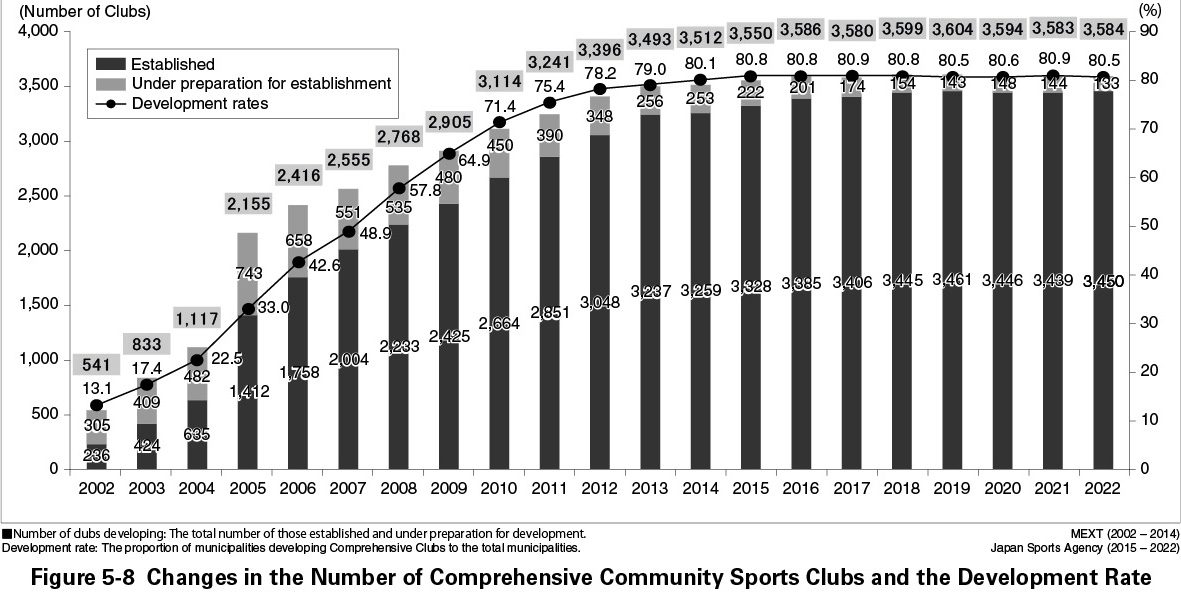This article highlights the following points;
1. Establishment and Development of Comprehensive Community Sports Clubs
2. Management of Comprehensive Community Sports Clubs
We use cookies to optimize and continuously improve our website for individual users. By closing this banner or continuing to view the website, you are agreeing to the use of cookies for this purpose, as detailed in our Privacy Policy.
This article highlights the following points;
1. Establishment and Development of Comprehensive Community Sports Clubs
2. Management of Comprehensive Community Sports Clubs
A comprehensive community sports club (hereinafter referred to as a “Comprehensive Club”) is a sport club that is independently run by local residents, usually at a public facility or a school facility that is open to the public. A comprehensive club has the following features: (a) multi-category (multiple categories of sport are offered so that local residents can choose the activities they prefer); (b) multi-generation (all age groups can participate in a variety of sports); (c) multi-purpose (people can participate in an activity that is well-suited to their level of skills and purpose). Since 1995, MEXT has been promoting the development of comprehensive clubs and the Japan Sports Agency (JSA) has succeeded the measure.
According to the JSA’s “Survey on the Development of Comprehensive Community Sports Clubs” (2022), the number of comprehensive clubs had increased by six times over the 10 years since the beginning of the survey in 2002 (Figure 5-8). The increase observed in 2005 was particularly significant, when the number of clubs almost doubled from 1,117 clubs in 2004, to 2,155 clubs in 2005. After 2006, the increase rate remained at around 3-8% when compared to the previous year. However, in 2013, the increase rate was even lower, growing by only 1% from the previous year. After 2013, the total number of comprehensive clubs remained flat and was 3,584, of which 3,450 clubs were operational and 133 clubs were in the process of establishment in 2022.
The Sport Basic Plan sets out policy goal that aims to continuously develop at least one comprehensive club in each municipality. Excluding the local communities with depopulation, 80% of the municipalities across the country now has established comprehensive clubs and it could be said that they were successful in achieving their goal.

The management of comprehensive clubs, such as the number of members, the financial conditions and the employment rate of club managers and staff members, can be assessed by “Survey on the Development of Comprehensive Community Sports Clubs”, which has been conducted by MEXT since 2003 and transferred to the JSA in 2015.
Regarding the number of the comprehensive club members and the changes observed over the years, the most prevalent size for a comprehensive club was 101 to 300 members, accounting for almost 40% of the total since 2005 (41.7% in 2022). Those with 300 or fewer members have shown a levelling off trend. Clubs with over 1,000 members accounted for less than 10% of the total (5.7% in 2022).
In terms of the budget sizes of each comprehensive club, those that had a budget of 1.01 million to 4 million yen accounted for around 50% of the total since 2005. However, this group decreased to around 30% in 2022, and clubs with a budget of 10 million or more increased instead. The survey in 2022 showed that the clubs with a budget of 1.01 million to 4 million yen consisted of 28.7 %.
Furthermore, regarding the internal revenue rate (based on the ratio of membership fees, operating costs and consignment costs compared to revenue), less than half of the comprehensive clubs (33.4%) had a 50% or lower internal revenue rate in 2022, and in fact this trend has improved since 2013 (53.6%). In most cases, other income came from government subsidies or grants. To ensure their sustainable operation, it is necessary that comprehensive clubs become more independent in their club management without the government subsidies or grants.